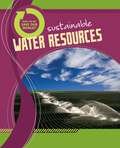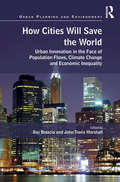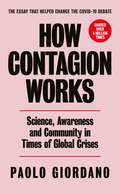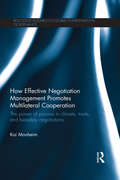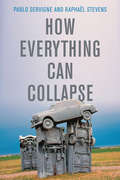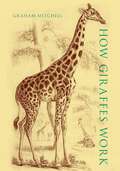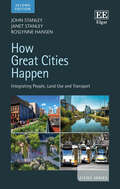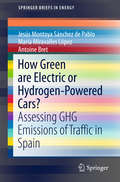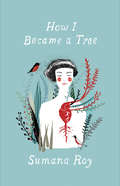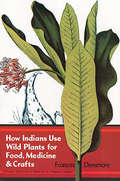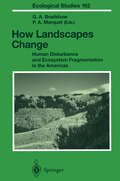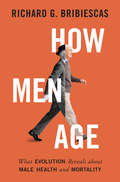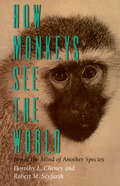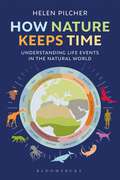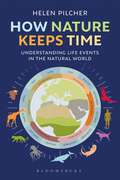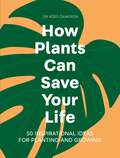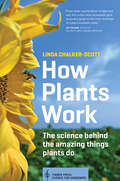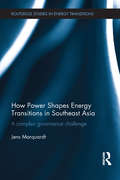- Table View
- List View
How Can We Save Our World? Sustainable Water Resources (How Can We Save Our World?)
by Anne RooneyHow Can We Save Our World looks at how the idea of sustainable development is having an increasing influence on a wide range of human activities. The books examine the environmental costs and unsustainable nature of modern life, and discuss ways in which society can progress toward a more sustainable future.Sustainable Water Resources describes the origins of the world's water and how we use water in our homes, industries, and agriculture. It discusses:€ The pressures on the water supply today€ How water shortages affect people's lives€ Technological solutions for providing clean water and processing water€ How we can use water more efficiently to ensure there is enough for all.
How Cities Will Save the World: Urban Innovation in the Face of Population Flows, Climate Change and Economic Inequality (Urban Planning and Environment)
by Ray Brescia John Travis MarshallCities are frequently viewed as passive participants to state and national efforts to solve the toughest urban problems. But the evidence suggests otherwise. Cities are actively devising innovative policy solutions and they have the potential to do even more. In this volume, the authors examine current threats to communities across the U.S. and the globe. They draw on first-hand experience with, and accounts of, the crises already precipitated by climate change, population shifts, and economic inequality. This volume is distinguished, however, by its central objective of traveling beyond a description of problems and a discussion of their serious implications. Each of the thirteen chapters frame specific recommendations and guidance on the range of core capacities and interventions that 21st Century cities would be prudent to consider in mapping their immediate and future responses to these critical problems. How Cities Will Save the World brings together authors with frontline experience in the fields of city redevelopment, urban infrastructure, healthcare, planning, immigration, historic preservation, and local government administration. They not only offer their ground level view of threats caused by climate change, population shifts, and economic inequality, but they provide solution-driven narratives identifying promising innovations to help cities tackle this century’s greatest adversities.
How Cities Will Save the World: Urban Innovation in the Face of Population Flows, Climate Change and Economic Inequality (Urban Planning and Environment)
by Ray Brescia John Travis MarshallCities are frequently viewed as passive participants to state and national efforts to solve the toughest urban problems. But the evidence suggests otherwise. Cities are actively devising innovative policy solutions and they have the potential to do even more. In this volume, the authors examine current threats to communities across the U.S. and the globe. They draw on first-hand experience with, and accounts of, the crises already precipitated by climate change, population shifts, and economic inequality. This volume is distinguished, however, by its central objective of traveling beyond a description of problems and a discussion of their serious implications. Each of the thirteen chapters frame specific recommendations and guidance on the range of core capacities and interventions that 21st Century cities would be prudent to consider in mapping their immediate and future responses to these critical problems. How Cities Will Save the World brings together authors with frontline experience in the fields of city redevelopment, urban infrastructure, healthcare, planning, immigration, historic preservation, and local government administration. They not only offer their ground level view of threats caused by climate change, population shifts, and economic inequality, but they provide solution-driven narratives identifying promising innovations to help cities tackle this century’s greatest adversities.
How Contagion Works: Science, Awareness and Community in Times of Global Crises - The essay that helped change the Covid-19 debate
by Paolo GiordanoThe Covid-19 pandemic is the most significant health emergency of our time.Writing from Italy in lockdown, physicist and novelist Paolo Giordano explains how disease spreads in our interconnected world: why it mattershow it impacts ushow we must reactExpanding his focus to include other forms of contagion - from the environmental crisis to fake news and xenophobia - Giordano shows us not just how we got here but also how we can work together to create change.Paolo Giordano is a physicist and the author of four bestselling novels. His article 'The Mathematics of Contagion' - published in Italy at the beginning of the Covid-19 emergency - was shared more than 4 million times and helped shift public opinion in the early stages of the epidemic.
How Effective Negotiation Management Promotes Multilateral Cooperation: The power of process in climate, trade, and biosafety negotiations (Routledge Research in Global Environmental Governance)
by Kai MonheimMultilateral negotiations on worldwide challenges have grown in importance with rising global interdependence. Yet, they have recently proven slow to address these challenges successfully. This book discusses the questions which have arisen from the highly varying results of recent multilateral attempts to reach cooperation on some of the critical global challenges of our times. These include the long-awaited UN climate change summit in Copenhagen, which ended without official agreement in 2009; Cancún one year later, attaining at least moderate tangible results; the first salient trade negotiations after the creation of the WTO, which broke down in Seattle in 1999 and were only successfully launched in 2001 in Qatar as the Doha Development Agenda; and the biosafety negotiations to address the international handling of Living Modified Organisms, which first collapsed in 1999, before they reached the Cartagena Protocol in 2000. Using in-depth empirical analysis, the book examines the determinants of success or failure in efforts to form regimes and manage the process of multilateral negotiations. The book draws on data from 62 interviews with organizers and chief climate and trade negotiators to discover what has driven delegations in their final decision on agreement, finding that with negotiation management, organisers hold a powerful tool in their hands to influence multilateral negotiations. This comprehensive negotiation framework, its comparison across regimes and the rich and first-hand empirical material from decision-makers make this invaluable reading for students and scholars of politics, international relations, global environmental governance, climate change and international trade, as well as organizers and delegates of multilateral negotiations. This research has been awarded the German Mediation Scholarship Prize for 2014 by the Center for Mediation in Cologne.
How Effective Negotiation Management Promotes Multilateral Cooperation: The power of process in climate, trade, and biosafety negotiations (Routledge Research in Global Environmental Governance)
by Kai MonheimMultilateral negotiations on worldwide challenges have grown in importance with rising global interdependence. Yet, they have recently proven slow to address these challenges successfully. This book discusses the questions which have arisen from the highly varying results of recent multilateral attempts to reach cooperation on some of the critical global challenges of our times. These include the long-awaited UN climate change summit in Copenhagen, which ended without official agreement in 2009; Cancún one year later, attaining at least moderate tangible results; the first salient trade negotiations after the creation of the WTO, which broke down in Seattle in 1999 and were only successfully launched in 2001 in Qatar as the Doha Development Agenda; and the biosafety negotiations to address the international handling of Living Modified Organisms, which first collapsed in 1999, before they reached the Cartagena Protocol in 2000. Using in-depth empirical analysis, the book examines the determinants of success or failure in efforts to form regimes and manage the process of multilateral negotiations. The book draws on data from 62 interviews with organizers and chief climate and trade negotiators to discover what has driven delegations in their final decision on agreement, finding that with negotiation management, organisers hold a powerful tool in their hands to influence multilateral negotiations. This comprehensive negotiation framework, its comparison across regimes and the rich and first-hand empirical material from decision-makers make this invaluable reading for students and scholars of politics, international relations, global environmental governance, climate change and international trade, as well as organizers and delegates of multilateral negotiations. This research has been awarded the German Mediation Scholarship Prize for 2014 by the Center for Mediation in Cologne.
How Everything Can Collapse: A Manual for our Times
by Pablo Servigne Raphael StevensWhat if our civilization were to collapse? Not many centuries into the future, but in our own lifetimes? Most people recognize that we face huge challenges today, from climate change and its potentially catastrophic consequences to a plethora of socio-political problems, but we find it hard to face up to the very real possibility that these crises could produce a collapse of our entire civilization. Yet we now have a great deal of evidence to suggest that we are up against growing systemic instabilities that pose a serious threat to the capacity of human populations to maintain themselves in a sustainable environment.In this important book, Pablo Servigne and Raphaël Stevens confront these issues head-on. They examine the scientific evidence and show how its findings, often presented in a detached and abstract way, are connected to people’s ordinary experiences – joining the dots, as it were, between the Anthropocene and our everyday lives. In so doing they provide a valuable guide that will help everyone make sense of the new and potentially catastrophic situation in which we now find ourselves. Today, utopia has changed sides: it is the utopians who believe that everything can continue as before, while realists put their energy into making a transition and building local resilience. Collapse is the horizon of our generation. But collapse is not the end – it’s the beginning of our future. We will reinvent new ways of living in the world and being attentive to ourselves, to other human beings and to all our fellow creatures.
How Giraffes Work
by Graham MitchellThere are few creatures more beautiful, aloof, and fascinating than giraffes. Their social and ecological impact has been documented by many researchers. However, the inner workings of extant giraffes are less well known. That is why Graham Mitchell decided to write How Giraffes Work: a comprehensive overview of the anatomy, physiology, and biochemistry--in short, the normal functions--of a free-living, wild animal in its natural environment. A zoologist, veterinarian, and physiologist, Mitchell explains how giraffes get through their day. Additionally, he takes readers through the evolution of their physical characteristics, such as their size, shape, and coat markings. His approach integrates history with the physiology, anatomy, biochemistry, behavior, evolution, genetics, ecology, climate science, and more. Each chapter follows the discovery and utility of a different characteristic of giraffes. Illustrated with over two hundred figures and diagrams, the book explains how giraffes might have evolved and survived over many millions of years as well as how our perception of them has changed throughout history. So, how do giraffes work? The answers lie in a story filled not only with the details of their internal working but also with the labors of the extraordinary scientists who have put so many pieces of this puzzle together.
How Giraffes Work
by Graham MitchellThere are few creatures more beautiful, aloof, and fascinating than giraffes. Their social and ecological impact has been documented by many researchers. However, the inner workings of extant giraffes are less well known. That is why Graham Mitchell decided to write How Giraffes Work: a comprehensive overview of the anatomy, physiology, and biochemistry--in short, the normal functions--of a free-living, wild animal in its natural environment. A zoologist, veterinarian, and physiologist, Mitchell explains how giraffes get through their day. Additionally, he takes readers through the evolution of their physical characteristics, such as their size, shape, and coat markings. His approach integrates history with the physiology, anatomy, biochemistry, behavior, evolution, genetics, ecology, climate science, and more. Each chapter follows the discovery and utility of a different characteristic of giraffes. Illustrated with over two hundred figures and diagrams, the book explains how giraffes might have evolved and survived over many millions of years as well as how our perception of them has changed throughout history. So, how do giraffes work? The answers lie in a story filled not only with the details of their internal working but also with the labors of the extraordinary scientists who have put so many pieces of this puzzle together.
How Great Cities Happen: Integrating People, Land Use and Transport (Cities series)
by John Stanley Janet Stanley Roslynne HansenUrban planners in developed countries are increasingly recognizing the need for closer integration of land use and transport. However, this updated second edition of How Great Cities Happen explains how crises like climate change and the lack of affordable housing demonstrate the urgent need for a broader approach in order to create and sustain great cities.Offering innovative solutions to these contemporary challenges, this second edition of How Great Cities Happen examines new and emerging directions in strategic land use transport planning and analyses how cities function as a home for future generations and other species. Taking an integrated approach, and building on the first edition, chapters explore a broad range of issues concerning strategic urban planning. These include planning for productivity growth; social inclusion and wellbeing, with a particular focus on planning cities for children and youth; housing affordability; environmental sustainability; and integrated governance and funding arrangements. New issues covered in this edition include pressing concerns like climate change and biodiversity protection. The authors adopt a meticulous yet non-technical and accessible approach, grounded in a blend of academic and real-world experience of cities.This transdisciplinary second edition will prove vital to students and scholars of urban planning, transport economics, and social and environmental policy, alongside professional planners and urban policymakers.
How Green are Electric or Hydrogen-Powered Cars?: Assessing GHG Emissions of Traffic in Spain (SpringerBriefs in Energy)
by Jesús Montoya Sánchez de Pablo María Miravalles López Antoine BretHave you ever wondered by how much CO2 emissions can be reduced by running cars electrically or with hydrogen as fuel? This Brief provides a quantitative answer to this question using the example of the combined road traffic in Spain. The authors calculate the resulting greenhouse gas (GHG) emissions for the production of hydrogen gas or the required electricity and installing and maintaining the necessary infrastructure. In this way, they can compare with the GHG emissions in the present situation of oil fueled cars. Using different scenarios, they obtain an assessment how much ‘greener’ the electric or hydrogen cars can get.The method described in this Brief is scalable and readily adaptable to other countries. It can thus be used for investigating sensible approaches and developing recommendations for a conversion. As expected, the results depend strongly on the production scenarios for hydrogen or electricity production. The wrong choice can even result in increased GHG emissions. A proper choice of the roadmap toward a more sustainable and greener future is of greatest importance – the results described in this Brief can serve as a valuable and useful guide on our way.
How Herbs Healed the World: And Other Stories of Remarkable Plants
by Connor Smith'The writing shines when recounting the stories behind these herbs, offering a blend of history and botanical fascination' - RHS, The GardenHerbs are wonderful things. Without them so much would not be possible. With the advance of science over the last two hundred years these once mystical plants have changed and saved countless lives, vastly improving our standard of living while providing us all with a much richer, healthier diet. Today, we take for granted a world full oflife-saving drugs, luxury cosmetics and exotic foods.This fascinating book will tell this story: revealing how poisons once used by the ancient Romans such as Deadly Nightshade are now being used in modern medicine or how the herbs used by indigenous people around the world have provided remedies for countless illnesses. It will explore the myths and legends behind herbs such as the infamous Mandrake and how herbs such as Yarrow are still being used to treat wounds today, just as they were thousands of years ago; and it will show how exotic herbs from across the globe have enriched our livesand delve into the origins of the culinary herbs that everyone knows and loves.Seventy-five herbs have been carefully chosen to tell the story of how they have each changed our world, looking back at their origins and what was once believed, while comparing this with the modern day uses and the scientific value of these plants enabling the reader to understand and appreciate their importance.Each double page spread will provide both historic and modern illustrations of each herb alongside captivating accounts of their historical and modern day uses including supplementary botanical and horticultural information for each.
How I Became a Tree
by Sumana RoyAn exquisite, lovingly crafted meditation on plants, trees, and our place in the natural world, in the tradition of Robin Wall Kimmerer’s Braiding Sweetgrass and Annie Dillard’s Pilgrim at Tinker Creek “I was tired of speed. I wanted to live tree time.” So writes Sumana Roy at the start of How I Became a Tree, her captivating, adventurous, and self-reflective vision of what it means to be human in the natural world. Drawn to trees’ wisdom, their nonviolent way of being, their ability to cope with loneliness and pain, Roy movingly explores the lessons that writers, painters, photographers, scientists, and spiritual figures have gleaned through their engagement with trees—from Rabindranath Tagore to Tomas Tranströmer, Ovid to Octavio Paz, William Shakespeare to Margaret Atwood. Her stunning meditations on forests, plant life, time, self, and the exhaustion of being human evoke the spacious, relaxed rhythms of the trees themselves. Hailed upon its original publication in India as “a love song to plants and trees” and “an ode toall that is unnoticed, ill, neglected, and yet resilient,” How I Became a Tree blends literary history, theology, philosophy, botany, and more, and ultimately prompts readers to slow down and to imagine a reenchanted world in which humans live more like trees.
How Indians Use Wild Plants for Food, Medicine & Crafts
by Frances Densmore"Learn the natural ways of the Chippewa Indians with this great book from Dover." — Texas Kitchen and Garden and MoreThe uses of plants — for food, for medicine, for arts, crafts, and dyeing — among the Chippewa Indians of Minnesota and Wisconsin show the great extent to which they understood and utilized natural resources. In this book those traditions are captured, providing a wealth of new material for those interested in natural food, natural cures, and native crafts.In separate sections describing the major areas of use, Miss Densmore, an ethnologist with the Smithsonian Institution, details the uses of nearly 200 plants with emphasis on wild plants and lesser-known uses. For those interested in natural foods she gives extensive coverage to the gathering and preparation of maple sugar and wild rice, as well as preparations for beverages from leaves and twigs of common plants, seasonings including mint and bearberry, the methods of preparing wild rice and corn, cultivated and wild vegetables, and wild fruits and berries. On Indian medicines she tells the basic methods of gathering plants and the basic surgical and medical methods. Then she gives a complete list of the plants with their botanical names, uses, parts used, preparation and administration, and other notes and references. Also covered are plants used as charms, plants used in natural dyes, and plants in the useful and decorative arts including uses for household items, toys, mats, twine, baskets, bows, and tools, with special emphasis on the uses of birch bark and cedar. This section will be especially useful for supplying new and unusual craft ideas. In addition, 36 plates show the many stages of plant gathering and preparation and many of the artistic uses. While a number of the plants discussed are native only to the Great Lakes region, many are found throughout a wide range.Those studying the Indians of the Great Lakes region, or those trying to get back to nature through understanding and using natural materials, will find much about the use of plants in all areas of community life. Because of Miss Densmore’s deep knowledge and clear presentation, her study remains a rich and useful source for learning about or using native foods, native cures, and native crafts.
How Landscapes Change: Human Disturbance and Ecosystem Fragmentation in the Americas (Ecological Studies #162)
by K. L. RonnenbergNorth and South America share similar human and ecological histories and, increasingly, economic and social linkages. As such, issues of ecosystem functions and disruptions form a common thread among these cultures. This volume synthesizes the perspectives of several disciplines, such as ecology, anthropology, economy, and conservation biology. The chief goal is to gain an understanding of how human and ecological processes interact to affect ecosystem functions and species in the Americas. Throughout the text the emphasis is placed on habitat fragmentation. At the same time, the book provides an overview of current theory, methods, and approaches used in the analysis of ecosystem disruptions and fragmentation.
How Men Age: What Evolution Reveals about Male Health and Mortality
by Richard G. BribiescasWhile the health of aging men has been a focus of biomedical research for years, evolutionary biology has not been part of the conversation—until now. How Men Age is the first book to explore how natural selection has shaped male aging, how evolutionary theory can inform our understanding of male health and well-being, and how older men may have contributed to the evolution of some of the very traits that make us human.In this informative and entertaining book, renowned biological anthropologist Richard Bribiescas looks at all aspects of male aging through an evolutionary lens. He describes how the challenges males faced in their evolutionary past influenced how they age today, and shows how this unique evolutionary history helps explain common aspects of male aging such as prostate disease, loss of muscle mass, changes in testosterone levels, increases in fat, erectile dysfunction, baldness, and shorter life spans than women. Bribiescas reveals how many of the physical and behavioral changes that we negatively associate with male aging may have actually facilitated the emergence of positive traits that have helped make humans so successful as a species, including parenting, long life spans, and high fertility.Popular science at its most compelling, How Men Age provides new perspectives on the aging process in men and how we became human, and also explores future challenges for human evolution—and the important role older men might play in them.
How Men Age: What Evolution Reveals about Male Health and Mortality
by Richard G. BribiescasWhile the health of aging men has been a focus of biomedical research for years, evolutionary biology has not been part of the conversation—until now. How Men Age is the first book to explore how natural selection has shaped male aging, how evolutionary theory can inform our understanding of male health and well-being, and how older men may have contributed to the evolution of some of the very traits that make us human.In this informative and entertaining book, renowned biological anthropologist Richard Bribiescas looks at all aspects of male aging through an evolutionary lens. He describes how the challenges males faced in their evolutionary past influenced how they age today, and shows how this unique evolutionary history helps explain common aspects of male aging such as prostate disease, loss of muscle mass, changes in testosterone levels, increases in fat, erectile dysfunction, baldness, and shorter life spans than women. Bribiescas reveals how many of the physical and behavioral changes that we negatively associate with male aging may have actually facilitated the emergence of positive traits that have helped make humans so successful as a species, including parenting, long life spans, and high fertility.Popular science at its most compelling, How Men Age provides new perspectives on the aging process in men and how we became human, and also explores future challenges for human evolution—and the important role older men might play in them.
How Monkeys See the World: Inside the Mind of Another Species
by Dorothy L. Cheney Robert M. SeyfarthCheney and Seyfarth enter the minds of vervet monkeys and other primates to explore the nature of primate intelligence and the evolution of cognition. "This reviewer had to be restrained from stopping people in the street to urge them to read it: They would learn something of the way science is done, something about how monkeys see their world, and something about themselves, the mental models they inhabit."—Roger Lewin, Washington Post Book World "A fascinating intellectual odyssey and a superb summary of where science stands."—Geoffrey Cowley, Newsweek "A once-in-the-history-of-science enterprise."—Duane M. Rumbaugh, Quarterly Review of Biology
How Monkeys See the World: Inside the Mind of Another Species
by Dorothy L. Cheney Robert M. SeyfarthCheney and Seyfarth enter the minds of vervet monkeys and other primates to explore the nature of primate intelligence and the evolution of cognition. "This reviewer had to be restrained from stopping people in the street to urge them to read it: They would learn something of the way science is done, something about how monkeys see their world, and something about themselves, the mental models they inhabit."—Roger Lewin, Washington Post Book World "A fascinating intellectual odyssey and a superb summary of where science stands."—Geoffrey Cowley, Newsweek "A once-in-the-history-of-science enterprise."—Duane M. Rumbaugh, Quarterly Review of Biology
How Monkeys See the World: Inside the Mind of Another Species
by Dorothy L. Cheney Robert M. SeyfarthCheney and Seyfarth enter the minds of vervet monkeys and other primates to explore the nature of primate intelligence and the evolution of cognition. "This reviewer had to be restrained from stopping people in the street to urge them to read it: They would learn something of the way science is done, something about how monkeys see their world, and something about themselves, the mental models they inhabit."—Roger Lewin, Washington Post Book World "A fascinating intellectual odyssey and a superb summary of where science stands."—Geoffrey Cowley, Newsweek "A once-in-the-history-of-science enterprise."—Duane M. Rumbaugh, Quarterly Review of Biology
How Nature Keeps Time: Understanding Life Events in the Natural World
by Helen PilcherAn accessible and thought-provoking introduction to timespans in the natural world, featuring more than 80 beautifully designed diagrams and charts.Which organisms live the longest? How does the natural world recover from wildfires? How long do eggs take to hatch? What are the world's fastest- and slowest- growing plants? Which species invest the most in parental care?The graphic number line is a potent pattern that explains much of our world, from the life cycle of immortal jellyfish to the perfect amount of time for a 'good sleep'. Beautifully illustrated with reader-friendly infographics and stunning colour photography, How Nature Keeps Time visually maps the amounts of time bounded by growth, distance, age, reproduction, sleep, death and other key behaviours. Join science and comedy writer Helen Pilcher as she examines a broad range of species from across the world and throughout time. As our natural world draws our attention to its plight, this fascinating book offers a calm, clear-thinking series of visual explanations based on the ultimate objective measure – time.
How Nature Keeps Time: Understanding Life Events in the Natural World
by Helen PilcherAn accessible and thought-provoking introduction to timespans in the natural world, featuring more than 80 beautifully designed diagrams and charts.Which organisms live the longest? How does the natural world recover from wildfires? How long do eggs take to hatch? What are the world's fastest- and slowest- growing plants? Which species invest the most in parental care?The graphic number line is a potent pattern that explains much of our world, from the life cycle of immortal jellyfish to the perfect amount of time for a 'good sleep'. Beautifully illustrated with reader-friendly infographics and stunning colour photography, How Nature Keeps Time visually maps the amounts of time bounded by growth, distance, age, reproduction, sleep, death and other key behaviours. Join science and comedy writer Helen Pilcher as she examines a broad range of species from across the world and throughout time. As our natural world draws our attention to its plight, this fascinating book offers a calm, clear-thinking series of visual explanations based on the ultimate objective measure – time.
How Plants Can Save Your Life: 50 Inspirational Ideas for Planting and Growing
by Ross CameronGrowing plants and (if we are lucky enough) creating gardens is deeply rewarding, but has also been proven to be vital for our health.Gardening helps improve our mood, relax us, take us away from our everyday problems, and promote positive emotions. It reduces anxiety and stress, delays in the onset of dementia, promotes joy, as well as improving physical health and even self-esteem.This new book explores the ways we can introduce plants into our lives and thus embrace some of the benefits the natural world provides for our well-being. Divided into 50 sections, each one highlights a plant-based activity, how this is good for your health and provides links to the underlying concept that supports health and well-being.Written by a leading scientific authority on environmental horticulture, this unique book will offer readers a wealth of ideas on planting and growing as well as explaining the latest science research behind those ideas.
How Plants Work: The Science Behind the Amazing Things Plants Do
by Linda Chalker-ScottHorticulturist Linda Chalker-Scott illuminates the fascinating mysteries of the garden in this engaging and accessible introduction to plant physiology.
How Power Shapes Energy Transitions in Southeast Asia: A complex governance challenge (Routledge Studies in Energy Transitions)
by Jens MarquardtAn understanding of the role of energy-related governance systems and the conditions required for a shift towards renewables in developing countries is urgently needed in order to tap into the global potential of low-carbon development. Although renewable energy sources have become technically feasible and economically viable, social and political factors continue to persist as the most critical obstacles for their dissemination. How Power Shapes Energy Transitions in Southeast Asia conceptualizes power for the field of sustainable energy governance. Based on empirical findings from the Philippines and Indonesia, the book develops an analytical approach that incorporates power theory into a multi-level governance framework. The book begins with a profound background on renewable energy development around the world and presents major trends in development cooperation. A power-based multi-level governance approach is introduced that is rooted in development thinking. Examining how coordination and power relations shape the development and dissemination of renewable energy technologies, the book also shows how decentralization affects low carbon development in emerging economies. Sparking debate on the ways in which energy transitions can be triggered and sustained in developing countries, this book will be of great interest to students and scholars of renewable energy development and environmental politics and governance as well as practitioners in development cooperation.
